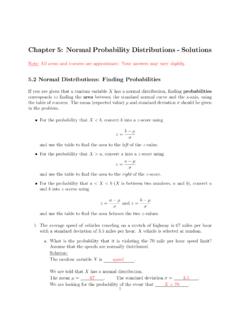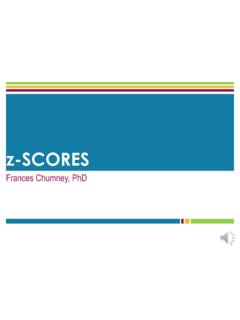Transcription of Statistics for Business and Economics
1 Modified 2/16/2010. EXCERPTS FROM: Solutions Manual to Accompany Statistics for Business and Economics Eleventh Edition David R. Anderson University of Cincinnati Dennis J. Sweeney University of Cincinnati Thomas A. Williams Rochester Institute of Technology The material from which this was excerpted is copyrighted by SOUTH-WESTERN. CENGAGE LearningTM. Contents 1. Data and Statistics .. 1. 2. Descriptive Statistics : Tabular and Graphical 2. 3. Descriptive Statistics : Numerical 5. 4. Introduction to Probability .. 8. 5. Discrete Probability 11. 6. Continuous Probability Distributions .. 13. 7. Sampling and Sampling Distributions .. 15. 8. Interval Estimation .. 17. 9. Hypothesis 18. 10. Statistical Inference about Means and Proportions with Two 22.
2 14. Simple Linear regression .. 25. 15. Multiple Regression .. 30. 16. Regression Analysis: Model Building .. 35. 21. Decision Analysis .. 37. 1. Data and Statistics 12. a. The population is all visitors coming to the state of Hawaii. b. Since airline flights carry the vast majority of visitors to the state, the use of questionnaires for passengers during incoming flights is a good way to reach this population. The questionnaire actually appears on the back of a mandatory plants and animals declaration form that passengers must complete during the incoming flight. A large percentage of passengers complete the visitor information questionnaire. c. Questions 1 and 4 provide quantitative data indicating the number of visits and the number of days in Hawaii.
3 Questions 2 and 3 provide qualitative data indicating the categories of reason for the trip and where the visitor plans to stay. 21. a. The two populations are the population of women whose mothers took the drug DES during pregnancy and the population of women whose mothers did not take the drug DES during pregnancy. b. It was a survey. c. 63 / = women out of each 1000 developed tissue abnormalities. d. The article reported twice as many abnormalities in the women whose mothers had taken DES. during pregnancy. Thus, a rough estimate would be = abnormalities per 1000 women whose mothers had not taken DES during pregnancy. e. In many situations, disease occurrences are rare and affect only a small portion of the population.
4 Large samples are needed to collect data on a reasonable number of cases where the disease exists. 1. 2. Descriptive Statistics : Tabular and Graphical Methods 15. a/b. Waiting Time Frequency Relative Frequency 0-4 4 5-9 8 10 - 14 5 15 - 19 2 20 - 24 1 Totals 20 c/d. Waiting Time Cumulative Frequency Cumulative Relative Frequency Less than or equal to 4 4 Less than or equal to 9 12 Less than or equal to 14 17 Less than or equal to 19 19 Less than or equal to 24 20 e. 12/20 = 29. a. y 1 2 Total A 5 0 5. x B 11 2 13. C 2 10 12. Total 18 12 30. b. y 1 2 Total A x B C 2. c. y 1 2. A x B C Total d. Category A values for x are always associated with category 1 values for y. Category B values for x are usually associated with category 1 values for y.
5 Category C values for x are usually associated with category 2 values for y. 50. a. Fuel Type Year Constructed Elec Nat. Gas Oil Propane Other Total 1973 or before 40 183 12 5 7 247. 1974-1979 24 26 2 2 0 54. 1980-1986 37 38 1 0 6 82. 1987-1991 48 70 2 0 1 121. Total 149 317 17 7 14 504. b. Year Constructed Frequency Fuel Type Frequency 1973 or before 247 Electricity 149. 1974-1979 54 Nat. Gas 317. 1980-1986 82 Oil 17. 1987-1991 121 Propane 7. Total 504 Other 14. Total 504. c. Crosstabulation of Column Percentages Fuel Type Year Constructed Elec Nat. Gas Oil Propane Other 1973 or before 1974-1979 1980-1986 1987-1991 Total d. Crosstabulation of row percentages. Fuel Type Year Constructed Elec Nat. Gas Oil Propane Other Total 1973 or before 1974-1979 1980-1986 1987-1991 3.
6 E. Observations from the column percentages crosstabulation For those buildings using electricity, the percentage has not changed greatly over the years. For the buildings using natural gas, the majority were constructed in 1973 or before; the second largest percentage was constructed in 1987-1991. Most of the buildings using oil were constructed in 1973. or before. All of the buildings using propane are older. Observations from the row percentages crosstabulation Most of the buildings in the CG&E service area use electricity or natural gas. In the period 1973 or before most used natural gas. From 1974-1986, it is fairly evenly divided between electricity and natural gas. Since 1987 almost all new buildings are using electricity or natural gas with natural gas being the clear leader.
7 4. 3. Descriptive Statistics : Numerical Methods xi 3181. 5. a. x= = = $159. n 20. b. Median 10th $160 Los Angeles 11th $162 Seattle 160 + 162. Median = = $161. 2. c. Mode = $167 San Francisco and New Orleans 25 . d. i= 20 = 5. 100 . 5th $134. 6th $139. 134 + 139. Q1 = = $ 2. 75 . e. i= 20 = 15. 100 . 15th $167. 16th $173. 167 + 173. Q3 = = $170. 2. 19. a. Range = 60 - 28 = 32. IQR = Q3 - Q1 = 55 - 45 = 10. 435. b. x= = 9. ( xi x ) 2 = 742. ( xi x ) 2 742. s2 = = = s = = n 1 8. c. The average air quality is about the same. But, the variability is greater in Anaheim. xi 765. 34. a. x= = = n 10. ( xi x ) 2 s= = =7. n 1 10 1. x x 84 b. z= = = s 7. Approximately one standard deviation above the mean. Approximately 68% of the scores are within one standard deviation.
8 Thus, half of (100-68), or 16%, of the games should have a winning score of 84 or more points. x x 90 z= = = s 7. 5. Approximately two standard deviations above the mean. Approximately 95% of the scores are within two standard deviations. Thus, half of (100-95), or , of the games should have a winning score of more than 90 points. x 122. c. x= i = = n 10. ( xi x ) 2 s= = = n 1 10 1. x x 24 Largest margin 24: z = = = . No outliers. s 50. a. 1. S&P 500. 0. -1. DJIA. xi xi b. x= = = .16 y= = = .13. n 9 n 9. xi yi ( xi x ) ( yi y ) ( xi x ) 2 ( yi y ) 2 ( xi x )( yi y ). Total 6. ( xi x )( yi y ) sxy = = = .3104. n 1 8. ( xi x ) 2 sx = = = .6120. n 1 8. ( yi y ) 2 sy = = = .5574. n 1 8. sxy .3104. rxy = = = .9098. sx s y (.6120)(.)
9 5574). c. There is a strong positive linear association between DJIA and S&P 500. If you know the change in either, you will have a good idea of the stock market performance for the day. 7. 4. Introduction to Probability 4. a. 1st Toss 2nd Toss 3rd Toss H (H,H,H). T. H (H,H,T). T. H (H,T,H). H. T. (H,T,T). T H (T,H,H). T. H (T,H,T). T. H (T,T,H). T. (T,T,T). b. Let: H be head and T be tail (H,H,H) (T,H,H). (H,H,T) (T,H,T). (H,T,H) (T,T,H). (H,T,T) (T,T,T). c. The outcomes are equally likely, so the probability of each outcomes is 1/8. 7. No. Requirement ( ) is not satisfied; the probabilities do not sum to 1. P(E1) + P(E2) + P(E3) +. P(E4) = .10 + .15 + .40 + .20 = .85. 21. a. Use the relative frequency method. Divide by the total adult population of million.
10 Age Number Probability 18 to 24 25 to 34 35 to 44 45 to 54 55 to 64 65 and over Total b. P(18 to 24) = .1309. c. P(18 to 34) = .1309 + .1757 = .3066. d. P(45 or older) = .1929 + .1437 + .1661 = .5027. 26. a. Let D = Domestic Equity Fund P(D) = 16/25 = .64. b. Let A = 4- or 5-star rating 13 funds were rated 3-star of less; thus, 25 13 = 12 funds must be 4-star or 5-star. P(A) = 12/25 = .48. c. 7 Domestic Equity funds were rated 4-star and 2 were rated 5-star. Thus, 9 funds were Domestic Equity funds and were rated 4-star or 5-star P(D A) = 9/25 = .36. 8. d. P(D A) = P(D) + P(A) - P(D A). = .64 + .48 - .36 = .76. 28. Let: B = rented a car for Business reasons P = rented a car for personal reasons a. P(B P) = P(B) + P(P) - P(B P).





